Brainstem Circuits for Locomotion
Locomotion requires coordinated muscle contraction driven by spinal networks, with the brainstem regulating initiation and speed. Our recent discoveries show that specific neurons in the brainstem also control turning. This work is critical to understanding locomotor deficits in Parkinson’s disease.
Circuit Mechanisms for Speed, Stop, and Turn
 |
|
|
Locomotion is a universal modality of movement that allows translation of the body from point to point. Locomotion requires precise temporal coordination between muscle groups, which is largely accomplished by rhythmic networks within the spinal cord itself. Executive spinal networks receive commands from the brainstem which regulate distinct features of locomotion, including initiation and speed (Ann Rev Neurosci, 2022).
While the brainstem circuits responsible for locomotor initiation and speed have been described in some detail, how descending circuits direct locomotor movements to the left or right side has remained unknown. Recently, we discovered that a small group of transcriptionally defined neurons in the medulla acts as the descending command for turning in mammals. To elaborate this discovery, we used a sophisticated suite of anatomical, electrophysiological, and behavioral approaches to demonstrate that Chx10 Gi neurons are required for moving left or right (Nat Neurosci, 2020).
The primacy of turning is exemplified in Parkinsonian patients, which exhibit exacerbated turning deficits often accompanied by falls. To understand how turning deficits arise in Parkinson’s disease, we have employed deep brainstem Ca2+ recording, intersectional viral tracing, and optogenetics to reveal how the basal ganglia engage brainstem motor programs to execute this complex movement (Nat Neurosci, 2024).